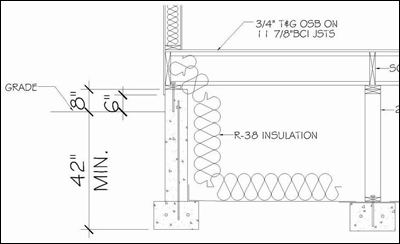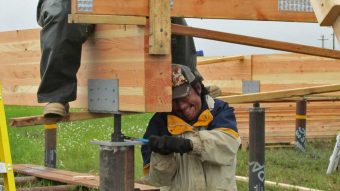Builders in Southcentral Alaska asked CCHRC to study an insulation strategy currently being recommended that involves insulating with R-38 batts from the rim joist down the foundation wall and four feet horizontally inward along the crawlspace floor. Through monitoring temperatures in and around foundations, CCHRC is investigating whether the technique may subject foundations to frost jacking.This model shows the freezing front (the dashed blue line) over the course of two years in the Anchorage climatic and soil conditions. Note how a foundation with no wall insulation keeps the frostline (blue dotted line) away from the bottom of the foundation, avoiding problems like frost jacking. Foundations with a large degree of insulation along the foundation wall and crawlspace floor, on the other hand, prevent heat loss into the ground and could make the foundation more susceptible to freezing.
 CCHRC is studying an insulation strategy currently being recommended in Southcentral Alaska that involves insulating with R-38 batts from the rim joist down the foundation wall and four feet horizontally inward along the crawlspace floor.
CCHRC is studying an insulation strategy currently being recommended in Southcentral Alaska that involves insulating with R-38 batts from the rim joist down the foundation wall and four feet horizontally inward along the crawlspace floor.
This strategy is substantially different from those designed to protect foundations from frost. Some homebuilders are concerned that the insulation may subject the foundation to freezing. To study the impact of this strategy, CCHRC is instrumenting and modeling in and around foundations of Anchorage homes.
While these topics have been studied extensively, the information and recommendations on best construction practices may not be sufficient or specific enough to prevent potentially risky insulation strategies from being used.
CCHRC is implementing computer modeling and instrumentation in and around foundations to analyze this insulation strategy. Our findings will be used to propose insulation strategies that balance the goals of frost protection and energy savings.
An interim report has been submitted to AHFC as well as Alaska homebuilders, energy raters, and building scientists for review and comments. Comments and feedback from these communities have been reviewed and incorporated into the interim report.
Phase 2
Based on preliminary findings from Phase I and feedback from the home building community, CCHRC designed a subsequent project phase and expand the scope of study.
As much of the research effort in Phase I was through finite element modeling, basic uncertainties were assumed during the modeling effort that may affect the outcome of the actual heat loss and freezing front penetration. Significant uncertainties include crawlspace temperatures, heterogeneity of soil types, and moisture contents. Despite these uncertainties, the modeling provides a more comprehensive understanding of the effect of varying factors (such as insulation values, soil composition, soil moisture content, etc.) and provides an avenue for future research. The next phase of this project may now be pursued with a more defined process and goal than could be achieved without prior modeling.
During this second phase of study, various site measurements were made to validate the model to existing site conditions and calibrate the model for its use in Anchorage. Instrumentation used in this phase included temperature and moisture sensors at various locations in the soil near the foundation as well as temperature sensors in the crawlspace of case study homes. The soil measurements were used to track the freezing front in the soil adjacent to the foundation.
An additional uncertainty of this modeling process is the accuracy of the subsurface characterization. Geotechnical analyses of multiple soil samples from sites in this next phase may prove useful in developing a better understanding of the sites and correlation to the model. Moisture content analyses will also be included such an analysis.
Although the initial focus on this study was based on the Anchorage and Southcentral Alaska area, this insulation strategy has also been suggested in other areas across Alaska. The findings from this Phase II work will inform whether subsequent phases of study include insulation strategies in various Alaskan climates, including the Fairbanks area. The results of this work will ultimately be used to propose insulation strategies that best meet the goals of frost protection and energy savings for both new construction and retrofit construction across Alaska.
Instrumentation and Data Collection
Four house sites will be chosen to collect soil temperature, moisture content, and geotechnical data. At each site, a geotechnical analysis of the soil adjacent to the foundation will be performed to characterize the physical soil properties. A string of temperature sensors and one moisture sensor will be installed adjacent to the foundation wall at varying depths down to six feet deep. At one of the house sites, two additional temperature strings will be installed on the east side and northeast corner of the house to help characterize corner heat loss. The data from all house sites will be collected after approximately six months in order to perform a preliminary analysis and model calibration (so that other modeling efforts can be started). The data from all house sites will be collected after one year of monitoring in order to perform a more complete temperature analysis and further refine the model.
Twenty house sites with crawlspaces were selected to characterize year-round crawlspace temperature regimes. Data loggers were installed at each site and data was collected after one year of monitoring. Data from four of the loggers was collected after six months in order to perform a preliminary analysis and model calibration.
Project Deliverables
A final report will provide a concise literature review, documentation of the study methods and findings, discussion on the relevance of the findings, field measurements, and implications for construction practices in Southcentral Alaska.










